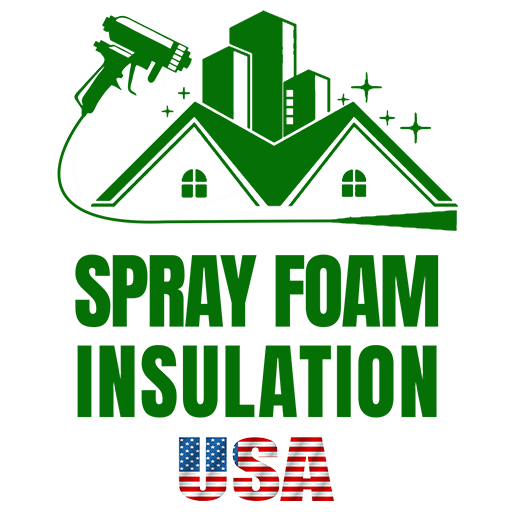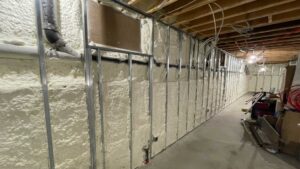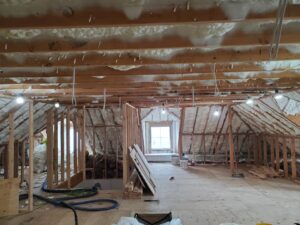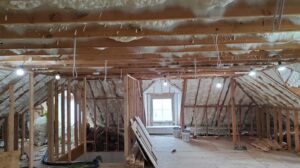Quick Guide to Home Insulation Solutions
- Thermal Curtains: Keep your rooms warmer in winter and cooler in summer.
- Seal Doors and Windows: Stop heat loss with new weatherstripping and door sweeps.
- Attic Insulation: Consider rolls or spray foam to keep heat from escaping.
- Insulate Pipes: Prevent heat loss and save water by insulating your water pipes.
- Insulate HVAC Ducts: Repair and insulate ducts to enhance efficiency.
Creating a comfortable living environment and saving on energy bills are two primary concerns for homeowners and business owners alike in NY and NJ. Insulation plays a crucial role in achieving these goals by maintaining temperature control throughout the seasons—keeping your space warm during the cold winters and cool during the hot summers. Additionally, thoughtfully installed insulation is key to an energy-efficient home or business, significantly reducing energy costs and contributing to a more sustainable planet.
Understanding the importance of proper insulation goes beyond comfort and cost-savings; it’s about building a sustainable future. Simple solutions, such as the installation of thermal curtains or the sealing of doors and windows, can make a noticeable difference. Meanwhile, more comprehensive measures like insulating attics, pipes, and HVAC ducts tackle more significant heat and energy losses.
Getting to the heart of home insulation means recognizing its direct link to energy efficiency. The right insulation solutions can drastically lower your energy consumption, leading to smaller carbon footprints and a healthier environment.

Understanding Home Insulation
When it comes to making your home more energy-efficient, understanding the basics of home insulation is crucial. Let’s break it down into simple parts: the types of insulation, what R-value means, and how insulation is installed.
Types of Insulation
There are several types of insulation, each suited for different areas of your home and offering various benefits. Here’s a quick overview:
-
Blanket: Batts and Rolls – This is the most common type and is made from materials like fiberglass, mineral wool, plastic fibers, and natural fibers. It’s best for areas without too many obstructions like unfinished walls, floors, and ceilings.
-
Foam Board or Rigid Foam – Made from polystyrene, polyisocyanurate, polyurethane, and phenolic, foam boards are great for insulating almost any part of your home, from roofs to unfinished walls.
-
Sprayed Foam and Foamed-in-Place – These are liquid foam materials that can be sprayed, injected, or poured. They offer excellent coverage, especially in nooks and crannies, making them ideal for sealing air leaks.
-
Loose-fill and Blown-in – Made from small particles of fiber, foam, or other materials, this type of insulation can conform to any space, making it suitable for retrofitting older homes where it might be difficult to install other types of insulation.
R-value: What Does It Mean?
The R-value is a measure of insulation’s ability to resist heat flow. The higher the R-value, the better the insulation’s effectiveness. When choosing insulation, look for a higher R-value if you live in a colder climate, as it means more warmth will be retained inside your home.
Installation Methods
The installation method depends on the type of insulation you choose:
-
DIY-friendly Options like blanket batts and rolls can be easily installed by homeowners. They are fitted between studs, joists, and beams, perfect for areas that are free from obstructions.
-
Professional Installation is recommended for more complex options like sprayed foam. This ensures that the insulation is applied correctly and safely, maximizing its efficiency and effectiveness.
-
Air Sealing is an essential step before installing insulation. Sealing leaks around doors, windows, and other openings can significantly improve your home’s energy efficiency.
Key Takeaways
-
Choose the Right Type: Consider the area you need to insulate and pick the insulation type that suits your needs and budget.
-
Pay Attention to R-value: Higher R-value means better insulation, especially important in colder climates.
-
Installation Matters: Proper installation is crucial. While some insulation types are DIY-friendly, others require professional expertise.
By understanding these basics, you’re well on your way to enhancing your home’s energy efficiency, comfort, and ultimately, saving on energy costs. The right home insulation solutions not only keep you warm in the winter and cool in the summer but also contribute to a healthier environment for you and the planet.
Next, we’ll explore the most effective insulation solutions for your home, focusing on options that offer the best energy efficiency and comfort year-round.
Most Effective Insulation Solutions
When it comes to keeping your home snug and reducing those hefty energy bills, not all insulation is created equal. Let’s dive into some of the top performers in home insulation solutions.
Foam Insulation
Foam insulation stands out as a superhero in the insulation world. It comes in two main heroes: spray foam and rigid foam boards. Spray foam is like the flexible gymnast, sneaking into cracks and gaps, expanding to fill them up. This makes it perfect for sealing air leaks around windows and doors. It’s like wrapping your home in a warm hug. Rigid foam boards are the steadfast guards, adding an extra layer of protection to walls and roofs, acting as a barrier against heat loss. Why it rocks: High R-values mean it’s super effective at stopping heat in its tracks. It can also beef up your home’s structure.
Blanket: Batts and Rolls
Moving on to batt insulation, this type is like the cozy quilt of the insulation family. Made mostly from fiberglass or mineral wool, it’s designed to fit snugly between the bones of your home – the joists and studs. Why you’ll love it: It’s perfect for DIY enthusiasts looking to cozy up unfinished spaces like attics. It’s easy on the wallet and doubles as a sound barrier.
Loose-fill and Blown-in
Imagine filling a pillowcase with soft, fluffy materials – that’s loose-fill and blown-in insulation for you. It’s great for getting into those hard-to-reach spots, like awkward attic spaces or wall cavities. What’s to like: It’s versatile and can fit into odd shapes and sizes, ensuring a snug fit and fewer drafts.
Reflective Systems
Taking a different approach, reflective systems or radiant barriers don’t slow heat; they bounce it away like a mirror. These are especially useful in hot climates, reflecting the sun’s heat away from your attic, keeping your home cooler. Big plus: They can significantly cut down on cooling costs and are super lightweight and easy to install.
As we’ve seen, there’s no one-size-fits-all when it comes to insulation. Whether you’re looking to beef up your home’s defenses against the cold with foam insulation, lay down a cozy layer with batts and rolls, fill in the gaps with loose-fill, or reflect heat away with radiant barriers, there’s an effective solution out there for you.
Next, we’ll look into cost-effective ways to insulate your home, ensuring you get the best bang for your buck while staying warm and toasty.
Cost-Effective Ways to Insulate Your Home
Insulating your home doesn’t have to drain your wallet. There are several budget-friendly strategies that can significantly enhance your home’s warmth and energy efficiency. Let’s dive into some practical and cost-effective insulation solutions.
Batt Insulation
Batt insulation is one of the most common and affordable ways to insulate your home. It comes in pre-cut panels, making it ideal for fitting between the studs in your walls and the joists in your floors and ceilings.
- Pros: It’s relatively easy to install, making it a great DIY project. Plus, it’s available in materials like fiberglass and mineral wool, which are effective at trapping heat.
- Tips: Wear protective gear when handling fiberglass to avoid irritation.
DIY Solutions
There’s a lot you can do on your own to improve your home’s insulation. Here are a few simple yet effective DIY solutions:
- Window Insulation Kits: These kits can help reduce heat exchange through your windows, a common source of energy loss in homes. They’re inexpensive and easy to install.
- Draft Stoppers: Use draft stoppers for doors and windows to block cold air from sneaking into your home. You can make your own using materials like old socks filled with rice or fabric scraps.
Weatherproofing
Sealing up leaks and drafts is a cost-effective way to keep the warm air in and the cold air out. Here’s how:
- Weatherstripping: Apply weatherstripping around doors and windows where you feel drafts.
- Caulking: Use caulking to seal cracks and gaps on the exterior of your home, especially around window frames and doorframes.
Thermal Curtains
Thermal curtains are an excellent investment for keeping your home warm in the winter and cool in the summer.
- What to Look For: When shopping for thermal curtains, look for ones labeled as “insulating” or “thermal.”
- DIY Tip: If you’re on a tight budget, you can improvise by hanging a blanket or a heavy fabric behind your existing curtains to add an extra layer of insulation.
By implementing these cost-effective insulation strategies, you can improve your home’s energy efficiency and comfort without breaking the bank. Even small changes can make a big difference in how warm and cozy your home feels.
Next, we’ll explore innovative insulation techniques that can further enhance your home’s energy efficiency. Stay tuned for tips on using sprayed foam, structural insulated panels (SIPs), and more to keep your home snug all year round.
Innovative Insulation Techniques
In the quest to make our homes more energy-efficient and comfortable, innovative insulation techniques play a pivotal role. Let’s dive into some of the cutting-edge solutions that are changing the game for homeowners.
Sprayed Foam Insulation
One of the most powerful tools in the home insulation arsenal is sprayed foam insulation. This method involves spraying a liquid foam that expands and hardens into an insulating layer. It’s like giving your home a tight, warm hug. Spray foam fills cracks and gaps with precision, creating an airtight seal that traditional insulation methods can’t match.
- Why it’s awesome: It blocks airflow and seals off leaks, which means your heating and cooling systems work less to keep you comfortable. Plus, it can keep out unwanted guests like bugs and rodents.
- Eco-friendly bonus: Spray Foam Insulation USA’s ECOTIF500® is a standout, combining high performance with environmental friendliness.
Structural Insulated Panels (SIPs)
Imagine building blocks that are not only strong but also super insulating. That’s what SIPs are. These panels consist of insulating foam sandwiched between two structural facings. They’re used for walls, roofs, and floors, offering a one-two punch of insulation and structural integrity.
- Why it’s awesome: SIPs can reduce energy bills by 12% to 14% compared to traditional construction. They also make buildings quieter and more comfortable.
Insulating Concrete Forms (ICFs)
ICFs are like LEGO for adults, but instead of playing, you’re building energy-efficient homes. These forms are used to pour concrete walls, and then they stay in place to provide insulation. It’s a sturdy, reliable way to keep your home at the right temperature.
- Why it’s awesome: Homes built with ICFs are known for their durability and resistance to natural disasters. Plus, they offer significant savings on heating and cooling costs.
Rigid Foam Boards
Rigid foam boards are versatile insulation heroes. They can be used in a variety of places, from roofs to basements. These boards are easy to cut and fit, making them a favorite among DIY enthusiasts and professionals alike.
- Why it’s awesome: Rigid foam boards have excellent moisture resistance and can be used in places where other insulations can’t, like under concrete slabs. They’re also great for adding insulation over existing surfaces.
By embracing these innovative insulation techniques, homeowners can significantly enhance their home’s energy efficiency. Whether you’re building a new house or upgrading your current one, solutions like sprayed foam, SIPs, ICFs, and rigid foam boards offer compelling benefits. Not only can they help reduce your energy bills, but they also contribute to a more sustainable, comfortable living environment.
Remember that the right insulation solution depends on your specific needs and home structure. But with options like these, you’re well on your way to a warmer, more energy-efficient home.
Next, we’ll address common insulation challenges and how to overcome them, ensuring your home is as cozy and efficient as possible.
Common Insulation Challenges and Solutions
When it comes to keeping your home warm in the winter and cool in the summer, insulation is key. But, not all insulation projects are straightforward. Let’s dive into some common challenges homeowners face and how to tackle them.
Air Sealing
The Challenge: Small leaks can add up to big problems. Air leaks around windows, doors, and electrical outlets can make your home feel drafty and lead to higher energy bills.
The Solution: Start with a simple smoke test to identify leaks. Hold a lit incense stick near potential leak spots. If the smoke wavers, you’ve found a leak. Seal these leaks with caulk or weatherstripping. It’s a simple, cost-effective fix that can make a big difference.
Insulating Existing Walls
The Challenge: Adding insulation to existing walls without tearing them down can seem daunting. It’s a common issue in older homes that may not have been properly insulated to begin with.
The Solution: Consider blown-in or spray foam insulation. These can be injected into walls through small holes, which are then patched up. This approach boosts your wall’s R-value without major renovation.
Attic Insulation
The Challenge: Heat rises, and if your attic isn’t properly insulated, it’s just rising right out of your house. An under-insulated attic is a common culprit for energy loss.
The Solution: Adding rolls of fiberglass insulation or using spray foam can significantly improve your attic’s insulation. Ensure you also pay attention to air sealing the attic floor to prevent warm air from escaping through gaps and cracks.
Basement and Crawlspace Insulation
The Challenge: Cold floors and high energy bills can often be traced back to uninsulated basements and crawlspaces. These areas can be tricky to insulate due to moisture issues and irregular spaces.
The Solution: Use rigid foam boards or spray foam insulation on the walls of your basement and crawlspace. This not only insulates but also acts as a barrier to moisture. If you’re dealing with a ventilated crawlspace, consider sealing off the vents and insulating the foundation walls instead of the floor above.
By addressing these common challenges with the right solutions, you can significantly enhance your home’s insulation. This leads to not only a more comfortable living environment but also reduced energy bills. Every home is unique, so it’s important to assess your specific situation and choose the insulation solutions that best meet your needs. With the right approach, overcoming these challenges is not only possible but can also be a rewarding investment in your home’s future.
Next, we’ll explore eco-friendly insulation options with Spray Foam Insulation USA, ensuring your home is not only cozy but also kind to the planet.
Enhancing Home Insulation with Spray Foam Insulation USA
When it comes to making your home more energy-efficient and comfortable, choosing the right insulation is key. Spray Foam Insulation USA offers innovative and eco-friendly solutions that not only keep your home warm in winter and cool in summer but also play a significant role in reducing your carbon footprint.
Eco-friendly Solutions
Spray foam insulation is a standout choice for homeowners looking to enhance their property’s energy efficiency. Unlike traditional insulation materials, spray foam offers exceptional air sealing properties. This means it can effectively block drafts and air leaks, which are common culprits of energy loss in homes. By creating a tighter building envelope, spray foam insulation helps maintain a consistent indoor temperature, reducing the need for heating and cooling. This not only saves energy but also lowers utility bills.
One of the key benefits of choosing Spray Foam Insulation USA is their commitment to sustainability. Their products are designed to minimize environmental impact, offering a greener alternative to traditional insulation methods. By reducing energy consumption, spray foam insulation helps decrease the amount of carbon dioxide emissions associated with heating and cooling homes. This makes it an excellent choice for environmentally conscious homeowners.
Spray Foam Insulation USA
Spray Foam Insulation USA stands out for its dedication to providing high-quality, eco-friendly insulation solutions. Their expert team conducts comprehensive evaluations of your home to identify specific areas that can benefit from improved insulation. This tailored approach ensures that your insulation upgrade addresses your home’s unique needs, maximizing energy efficiency and comfort.
Customers rave about the significant improvements they’ve noticed after installing spray foam insulation. From reduced drafts and noise to lower energy bills, the benefits are clear. Here’s what one satisfied customer had to say:
“After Spray Foam Insulation USA insulated our home, we noticed an immediate difference in comfort and our energy bills dropped significantly. It’s great knowing we’re also making a positive impact on the environment.”
Spray Foam Insulation USA offers a range of energy-efficient options to suit various budgets and home types. Whether you’re looking to insulate a new construction project or upgrade an existing home, they have the expertise and products to meet your needs.
Conclusion
Choosing the right insulation is crucial for enhancing your home’s energy efficiency and comfort. With Spray Foam Insulation USA, you can enjoy the benefits of a well-insulated home while supporting eco-friendly practices. Their commitment to quality, sustainability, and customer satisfaction makes them a leading provider of home insulation solutions.
Let’s dive into some common questions homeowners have about insulation, including the most effective and cost-efficient ways to insulate a house and tips for making your home more insulated.
Frequently Asked Questions about Home Insulation
Insulating your home is a smart move for comfort, energy savings, and the environment. But, with all the options out there, it can get a bit overwhelming. Let’s break down some of the most common questions in simple terms.
What is the most effective insulation for a house?
The effectiveness of insulation is measured by its R-value — the higher the R-value, the better it insulates. Spray foam insulation stands out due to its high R-value and ability to form an air seal, making it highly effective at keeping your home warm in winter and cool in summer. It’s versatile, too, fitting into tricky spaces where traditional insulation might not work as well.
What is the most cost-effective way to insulate a house?
When we talk about cost-effectiveness, we’re looking at both the upfront cost and the long-term savings on your energy bills. Batt insulation, made from fiberglass or mineral wool, is affordable and relatively easy to install yourself, making it a popular choice. However, focusing on air sealing and attic insulation can give you the most bang for your buck, as these areas often have the biggest impact on your home’s energy efficiency.
How can I make my house more insulated?
Making your house more insulated doesn’t always mean a major overhaul. Here are a few simple steps:
- Seal leaks: Use caulk or weather stripping around doors, windows, and places where plumbing or electrical lines enter the house.
- Upgrade attic insulation: Since heat rises, improving your attic’s insulation can significantly reduce heat loss.
- Add insulation to walls: This might require professional help, especially in existing homes, but it can make a big difference in your home’s comfort and efficiency.
Every home is unique, so what works best for one house might not be the best solution for another. Assessing your specific situation and consulting with professionals like those at Spray Foam Insulation USA can help you make informed decisions that lead to significant energy savings and improved comfort.
Improving your home’s insulation is a journey towards a more energy-efficient, comfortable living space. With the right approach and materials, you can enjoy lower energy bills, a smaller carbon footprint, and a cozier home year-round.
Conclusion
In wrapping up our comprehensive guide on home insulation solutions, it’s clear that the path to a more energy-efficient and comfortable home is through strategic insulation. By prioritizing areas in your home that need insulation and choosing the right materials, you can achieve remarkable energy savings. This not only lowers your monthly utility bills but also contributes to a healthier planet by reducing your overall energy consumption.
Energy Savings: The first and perhaps most compelling benefit of proper home insulation is the potential for significant energy savings. By creating a barrier that minimizes heat transfer, insulation keeps your home warmer in the winter and cooler in the summer. This means your heating, ventilation, and air conditioning (HVAC) system doesn’t have to work as hard to maintain a comfortable indoor temperature, leading to lower energy consumption and, consequently, reduced energy bills.
Comfort Improvement: Beyond the financial benefits, enhancing your home’s insulation directly impacts your comfort level. Insulated homes have fewer drafts, maintain more consistent temperatures, and are generally quieter, creating a more pleasant living environment. Whether it’s the peak of summer or the dead of winter, a well-insulated home provides a sanctuary that feels just right.
Spray Foam Insulation USA: When it comes to implementing effective insulation solutions, Spray Foam Insulation USA stands out as a leader in the field. Our eco-friendly spray foam insulation offers superior air sealing and moisture resistance, tackling common insulation challenges head-on. With our customized solutions, we assess your home to tailor the insulation to your specific needs, ensuring maximum energy efficiency and comfort.
By choosing Spray Foam Insulation USA, you’re not just insulating your home; you’re making a smart, long-term investment in your property. Our expert team ensures that the installation process is smooth and efficient, providing you with peace of mind and significant returns on your investment through energy savings and improved home comfort.
In conclusion, taking steps to improve your home’s insulation is one of the most effective ways to enhance your living space’s energy efficiency and comfort. With the right strategies and solutions, such as those offered by Spray Foam Insulation USA, you can enjoy a warmer, more comfortable home in the winter and a cooler, more pleasant environment in the summer. All while saving money and contributing to a more sustainable world.





